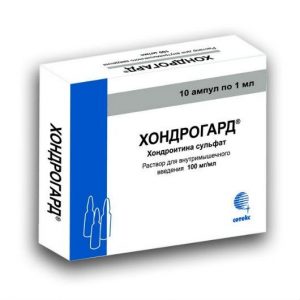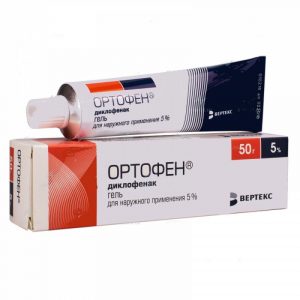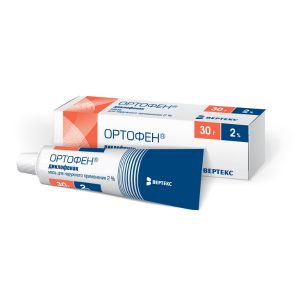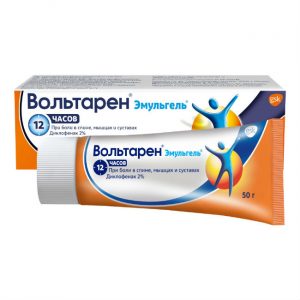Description
Description
Transparent to slightly yellow, colorless to slightly yellowish.
Release form
Solution for i / m administration.
Packing
5 ampoules of 3 ml.
Pharmacological action
Diclofenac is a non-steroidal anti-inflammatory drug (NSAID). It has anti-inflammatory, analgesic and antipyretic effects. It inhibits the COX enzyme in the cascade of arachidonic acid metabolism and disrupts the biosynthesis of prostaglandins.
Indications
For short-term symptomatic treatment of pain of various genesis of moderate intensity: Inflammatory and degenerative diseases of the musculoskeletal system: rheumatoid, psoriatic, juvenile chronic arthritis, ankylosing spondylitis (ankylosing spondylitis, gouty arthritis, rheumatoid arthritis, rheumatoid arthritis, rheumatoid arthritis, rheumatoid arthritis, rheumatoid arthritis, rheumatoid arthritis, rheumatoid arthritis, soft tissue (including with a radicular syndrome) lumbago, sciatica, neuralgia algodismenorea, inflammatory processes of organs are few of the pelvis, including adnexitis, post-traumatic pain syndrome, renal colic accompanied by inflammation postoperative pain.
Contraindications
Hypersensitivity (including other NSAIDs or auxiliary components), erosive and ulcerative lesions of the gastrointestinal tract (GIT) in the acute phase, bleeding from the gastrointestinal tract. inflammatory bowel disease in the acute phase (ulcerative colitis, Crohn’s disease), severe liver failure or liver disease in the acute period, severe renal failure (creatinine clearance less than 30 ml / min), progressive kidney disease, hyperkalemia, bronchial obstruction, rhinitis, urticaria, provoked taking acetylsalicylic acid or other NSAIDs (including history) hematopoiesis, hemostasis (including hemophilia), pregnancy, childhood (up to 18 years), chest karmlivaniya period after coronary artery bypass surgery, confirmed chronic heart failure (NYHA class II-IV functional class), coronary heart disease, peripheral arterial disease, or cerebrovascular disease uncontrolled arterial hypertension.
Use during pregnancy and lactation
Contraindicated.
Composition
Composition per 1 ml of the preparation: active ingredient: diclofenac sodium 25.0 mg excipients: benzyl alcohol, sodium metabisulfite, mannitol, sodium hydroxide, propylene glycol, water for injection.
Dosage and administration of
In order to reduce the risk of adverse events, the drug is recommended to be used in the minimum effective dose for the shortest period of time necessary to relieve symptoms. In order to avoid damage to the nerve or other tissues at the injection site, the instructions for intramuscular injection should be strictly observed. The injection solution is injected deeply intramuscularly (in the upper outer quadrant of the gluteal region). A single dose for adults is 75 mg (1 ampoule). If necessary, repeated administration is possible, but not earlier than after 12 hours. The second injection should be carried out in the opposite gluteal region. The maximum recommended daily dose of the drug Diclofenac solution for intramuscular injection is 150 mg. The duration of use is not more than 2 days, if necessary, then they switch to oral or rectal administration of diclofenac. One ampoule of 75 mg of the drug can be combined with other dosage forms of diclofenac (enteric-coated tablets, rectal suppositories), while you should pay attention to the fact that the maximum daily dose of diclofenac should not exceed 150 mg.
Side effects
Criteria for assessing the frequency of adverse reactions: very often (> 1/10), often (> 1/100, <1/10), infrequently (> 1/1000, <1/100), rarely (> 1 / 10 LLC, <1/1000), very rarely (<1/10 000) the frequency is unknown (according to available data, it is not possible to establish the frequency of occurrence). Drug Interaction When Diclofenac is co-administered with digoxin, phenytoin or lithium drugs may increase the plasma concentrations of these drugs with diuretics and antihypertensives – may reduce the effect of these drugs with potassium-sparing diuretics – may develop hyperkalemia with acetylsalicylic acid – decrease the concentration of diclofenac in plasma effects. Diclofenac may increase the toxic effect of cyclosporine on the kidneys. Diclofenc can cause hypo- or hyperglycemia, so blood glucose monitoring is required when used concomitantly with hypoglycemic agents. When using methotrexate for 24 hours before or after taking Diclofenac, it is possible to increase the concentration of methotrexate and increase its toxic effect. When co-administered with anticoagulants, regular monitoring of blood coagulation is required. Overdose Symptoms: vomiting, gastrointestinal bleeding, epigastric pain, diarrhea, dizziness, tinnitus, lethargy, convulsions, rarely – elevation of blood pressure, acute renal failure, hepatotoxic action, respiratory depression, coma. Treatment: gastric lavage, activated charcoal, symptomatic therapy aimed at eliminating hypertension, impaired renal function, convulsions, gastrointestinal irritation, respiratory depression. Forced diuresis, hemodialysis are ineffective (due to significant protein binding and intense metabolism). Storage conditions At a temperature of 15 to 25 ° C. Keep out of the reach of children! Expiration At 15 to 25 ° C. Keep out of reach of children! Deystvuyuschee substances Diclofenac




